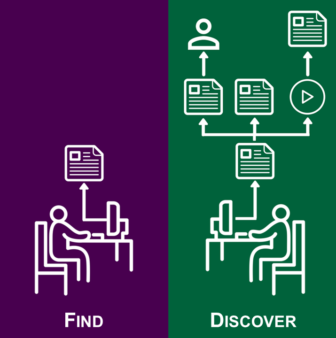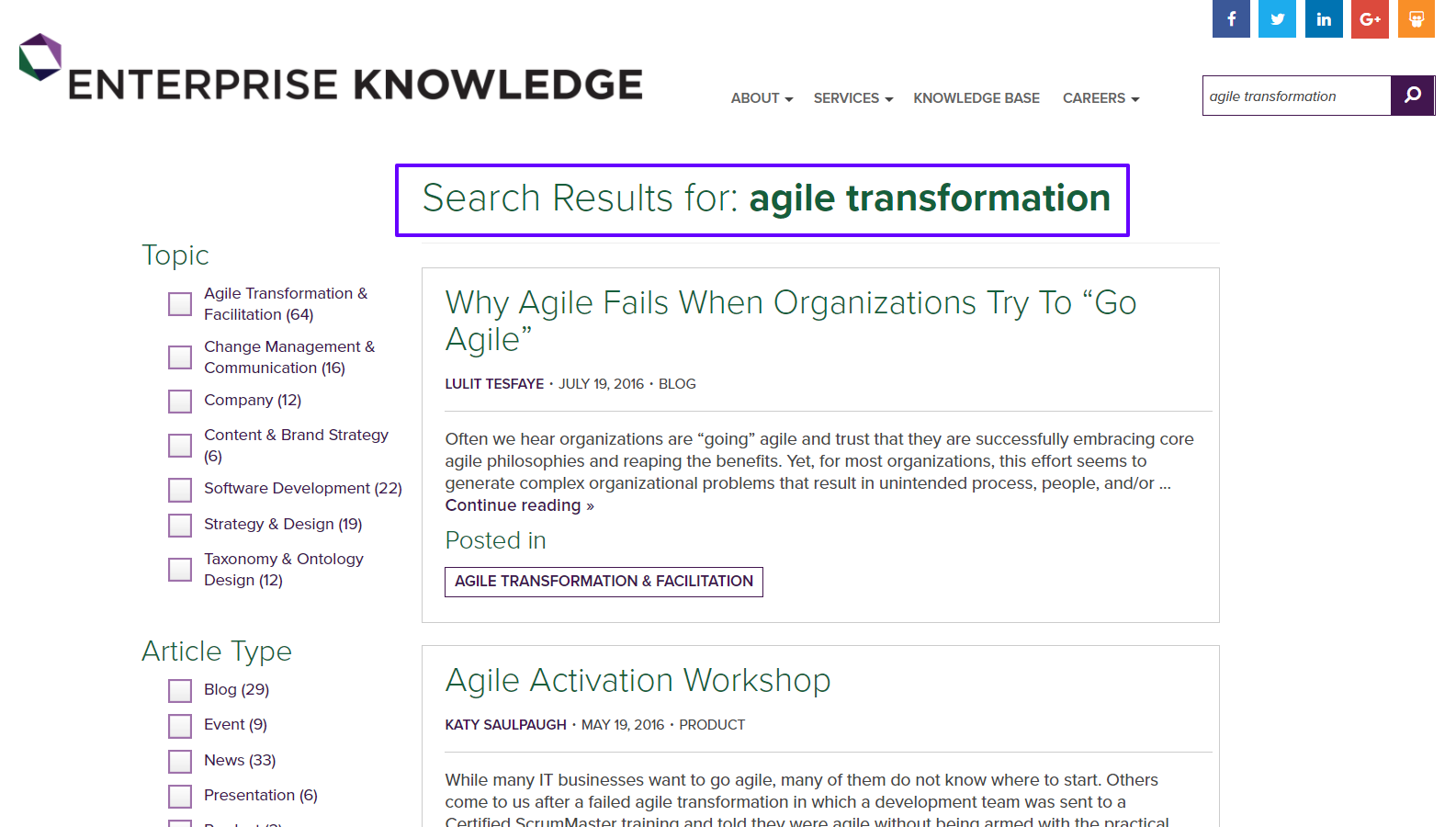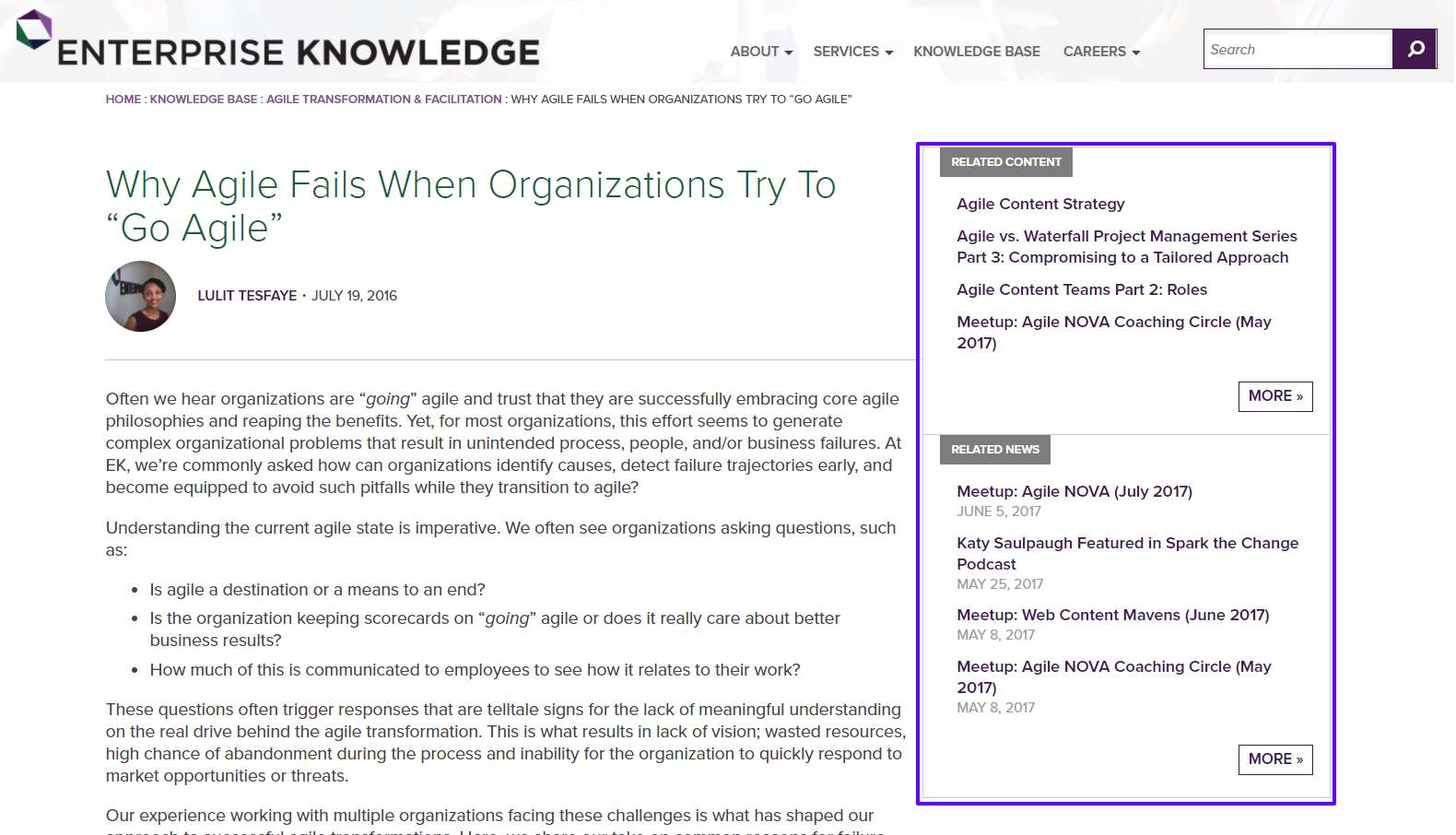At first glance, the terms “findability” and “discoverability” may seem similar, if not the same. However, these terms are distinct, and both are key outcomes that should be considered in any comprehensive Knowledge Management (KM) strategy. In this blog, you’ll learn:
- The differences between findability and discoverability;
- Why they’re equally important; and
- How they manifest in successful KM initiatives.

Findability v. Discoverability: What’s the Difference?
Findability is a term for the ease with which information can be found. It means that users can easily find content or information they assume is present on a website. As an example, if I’m looking on EK’s website for information about Agile Transformations, I can search for a specific term (agile transformation), and find information about the topic.

However, users rarely know all of the content on your website. A good knowledge management strategy also promotes discoverability, which involves making sure that new content or information can be found, even if the user(s) don’t know that it exists yet.
Let’s say that after clicking on and reading through the first search result (“Why Agile Fails When Organizations Try to ‘Go Agile’”), I’ve realized that, while this content addresses my initial search, I’d like to find out more.

In the image above, the right hand side of the page has lists of “Related Content” and “Related News”, which enable me as a user to further explore and discover other content that’s, for instance, about the same core topics, by the same author, or of the same type.
Findability and Discoverability for Improved User Experience
Findability and discoverability are important because they address two distinct needs of end users searching for the content they need. A user’s informational needs are not satisfied solely through finding content that they know exists, or exclusively through discovering information that they hadn’t known about previously. A user’s goals constantly change between finding specific information and discovering new information, and any well-thought-out KM strategy needs to accommodate both.
The findability/discoverability challenge is even more critical when considering intranets, knowledge bases, and other internal content/document management systems, where users may need to wade through thousands of documents to find what they’re seeking. Below are three ways that findability and discoverability manifest in KM initiatives.
Well-Designed Main Navigation
Helping your users navigate efficiently should always be a high priority. Simply relying on keyword search will not be enough. A well-designed and prominent main navigation menu acts as a map that directs your end users to the information they’re seeking. Here are several tips that will help ensure that your navigation menu is easily findable for end users:
- Keep it simple. Strip down your navigation menu to the bare minimum and keep only the menu items which direct users to the most sought-after content on your site.
- Give your main navigation menu the visual weight it deserves. Consider font and icon size, and the color contrast (especially as it relates to links within your navigation).
- Consider responsive design. Users increasingly access web content on mobile devices rather than on a desktop monitor. It’s essential to consider how your menu will look on a tablet, and a smartphone. Less screen space means less content, so be purposeful in deciding what information people really need to see in your navigation menu.
Facted Navigation
Faceted navigation is something that sounds complex, but is easy to recognize in practice. Faceted navigation means picking the facets (or filters) that a user will utilize to choose their own search path. For example, if I wanted to buy a pair of shoes, some facets that I would like to use to filter my search results could include shoe size, color, and heel height.
Determining what values to use as filters for your organization’s content can be tricky, because every organization has unique needs and situations which shape how their information should be organized. Through our business taxonomy design workshops, we help organizations to identify and prioritize these facets.
Related Content
Too often, websites miss opportunities to further engage their end users beyond their first click online. However, this isn’t necessarily due to the quality of your content, but rather the discoverability of your content.
One way to improve your content’s discoverability is by offering relevant links to content that is related to the original inquiry. While this process may seem straightforward, there are several tips to consider:
- Keep it simple. Simplicity reigns once again. It’s impossible to be completely accurate when deciding which links to share as related content, so it can be tempting to provide more to address all possibilities. This can easily overwhelm the end user, so cap the related links at five to seven.
- The level of specificity of related links depends on where the user is within the site. Offer a broader range of suggestions for posts on main pages, because they act as a bridge to content that end users may not have considered yet. On a topic-specific landing page, offer only related links which are relevant to that topic.
- Don’t disregard visual design. Typically, websites reserve the right side of a webpage for less important information (e.g., advertisements). As a result, it’s critical to avoid any visual elements similar to advertisements when designing your related content, because content is more likely to be ignored in that format.
Closing
Findability and discoverability are key outcomes for any comprehensive KM strategy, but improving both begins with keeping your users and their needs at the center of your efforts. In turn, you’ll ensure that your organization’s information is findable, manageable, and reusable for those who need it. Need help improving the findability and discoverability of your content? Contact Enterprise Knowledge to learn more.
